- Books Name
- Physics by Anshu Physics Book
- Publication
- Madhava Publications
- Course
- CBSE Class 12
- Subject
- Physics
Electrostatic Potential
Introduction
The concept of potential can only be understood only when you first understand conservative forces. As we can define potential with only those forces that are conservative in nature. For example, we have the gravitational potential for gravitational forces, and electrostatic potential for electrostatic ( Coulomb’s ) force, as these forces are conservative forces. Have anyone heard of frictional potential or drag potential?. There is no way we can have these potentials as frictional forces and drag forces are not conservative.
Now the next question is what exactly is a conservative force and how do we define it? Let's start it.
Conservative forces
There are many forms of energy: light energy, heat energy, sound energy, potential energy, kinetic energy, chemical energy etc.
But in mechanics, we define mechanical energy. Mechanical energy basically is the sum of potential energy and kinetic energy.
In mechanics when we say that total energy must remain the same; that is we are referring to the mechanical energy of the system
We say that under the effect of conservative forces the mechanical energy of the isolated system remains conserved.
Significance of conservative forces
The work done is independent of the path taken.

Suppose we have two points A and B, there can be many ways to reach B from A. The three possible paths are shown in the figure. Suppose the work done in reaching B from A via path 1 is W1 and similarly, we have W2 and W3 as work done for paths 2 and 3 respectively. So If the force would be conservative then W1=W2=W3.
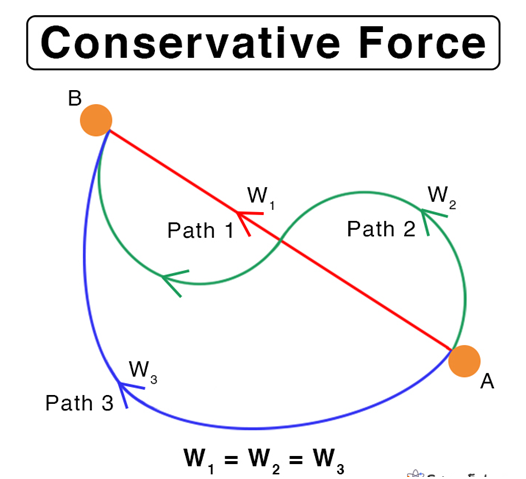
- Under conservative forces, the mechanical energy remains conserved.
If a body is subjected to conservative force and if its kinetic energy increases by some amount, its potential energy will decrease by the same amount to keep the total mechanical energy constant.
Let us try to understand this with the help of an example
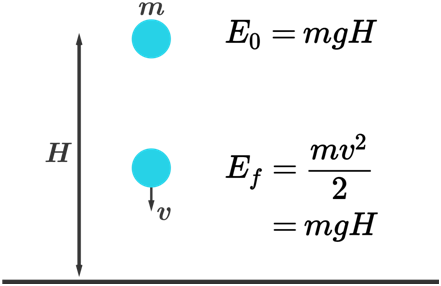
- Suppose we have a body of mass m, kept at height H. At this point, the body possesses potential energy “mgH”. Suppose you drop that object and it starts coming down.
- Now which force will be acting on this object falling down? Gravitational force. Agree? From our discussion, we know the gravitational force is a conservative force.
- So due to gravity, there will be a downward force on the object, so there is acceleration in the downward direction too. We call this acceleration “acceleration due to gravity g “.
- So Due to acceleration in the downward direction, the speed of the object increases as it falls down and hence the Kinetic energy of the particle also increases.
- But Since the gravitational force is a conservative force, mechanical energy under this force must be constant so as Kinetic energy increases, its potential energy decreases by the same amount.
- At the lowest position, just before hitting the surface it will have maximum kinetic energy and have velocity say “V” and potential energy will be zero, as all of the Potential energy gets converted into Kinetic energy.
mgH= (½)mV^2
By the above equation, we can find the maximum velocity attained by the object of mass “m” when it is dropped from height “H”.
The above example is to demonstrate how the energy remains conserved in conservative force and what is conservative force?
Now we can move further. Our next discussion is about Potential energy.
Potential energy
When we do some work against the conservative force the work we do gets converted into the potential energy of the body.

Example
- lifting an object to a height “H” against gravitational force stores potential energy of “mgH”.
- Compressing or expanding a spring by distance “x” introduces potential energy of (½)kx^2 In the spring of spring constant.
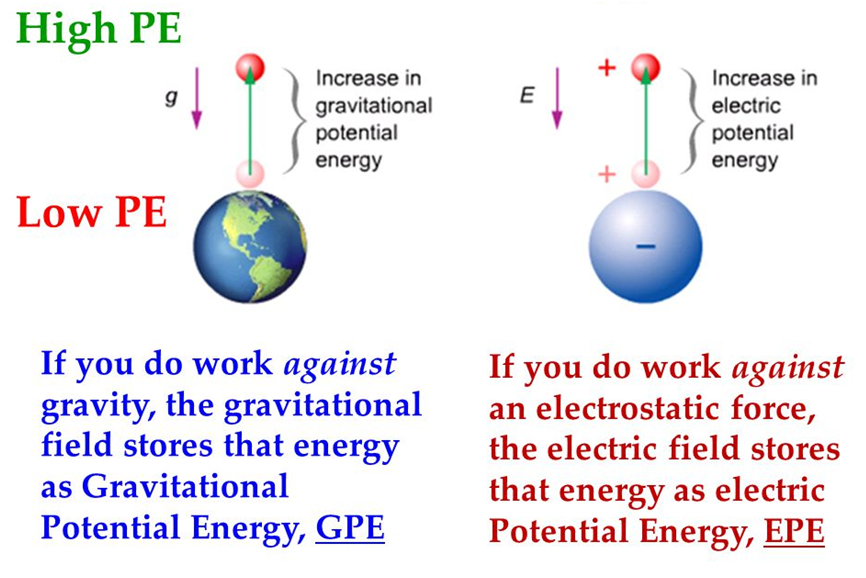
The way we have gravitational P.E we have electric potential energy as well.
Electrostatic potential energy.
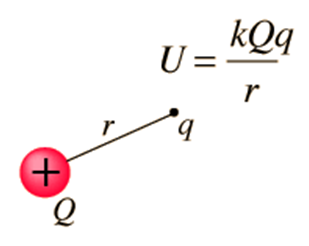
Suppose we have a charge Q placed at the origin. This Charge will have an electric field E around it. Now imagine we have a test charge “q” and we have to bring the test charge from infinity to Point R which is at distance r from the Q. Imagine both charges are of the same sign (Say positive).
Now while bringing the test charge “q” at point R, we have to work against the repulsive force due to charge Q as both are positive signs.

Assumptions:
- The test charge q is so small that it does not disturb the original configuration, here charge Q at the origin.
- We assume that we are bringing the test charge without acceleration, with constant speed so the external force just balances the repulsive force due to Q.
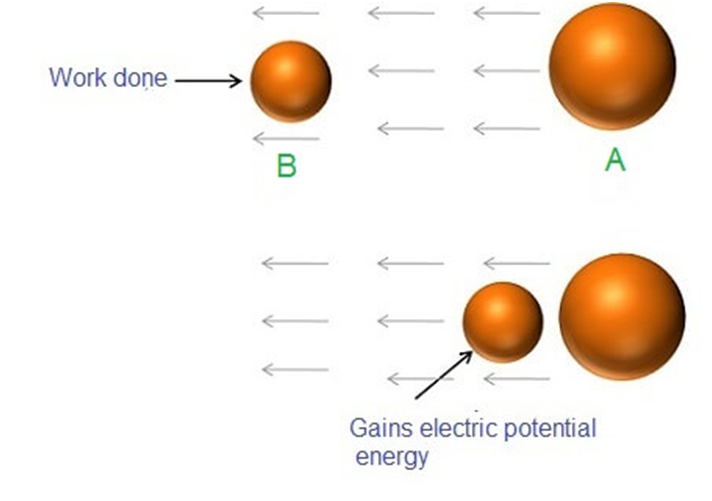
Points to be considered here:
- The external force must be in the opposite direction to the electrostatic repulsion force.
- The work done by an external force is negative to the work done by the electric force.
- If an external force is removed, the electric force will take charge and push the test charge q away and thus it will get some kinetic energy.
- The gain in kinetic energy after the removal of external force happens at the cost of loss of potential energy.
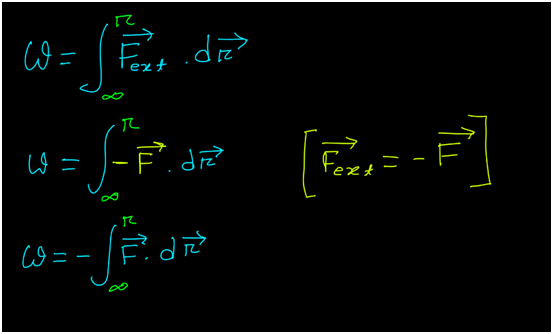
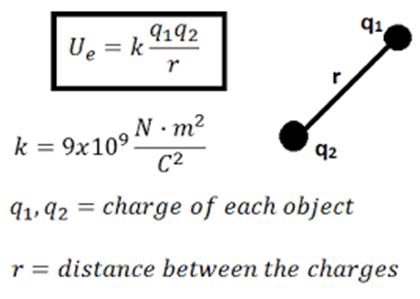
So we have discussed potential energy due to two charges Q and q separated by a distance “r”.
We notice here that electric potential energy and electric potential are proportional to charge “q” and inversely proportional to distance “r”.
I can surely say that at this point you might be wondering what is the difference between electric potential energy and electric potential.
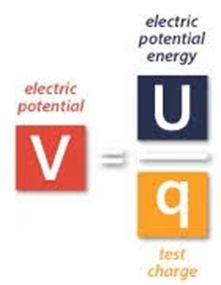
Electric potential energy is the work done in bringing the charge from infinity to a point in the electrostatic field of a charge.
The Unit of Electric potential energy is the same as work done and which is Joules. It is a scalar quantity.
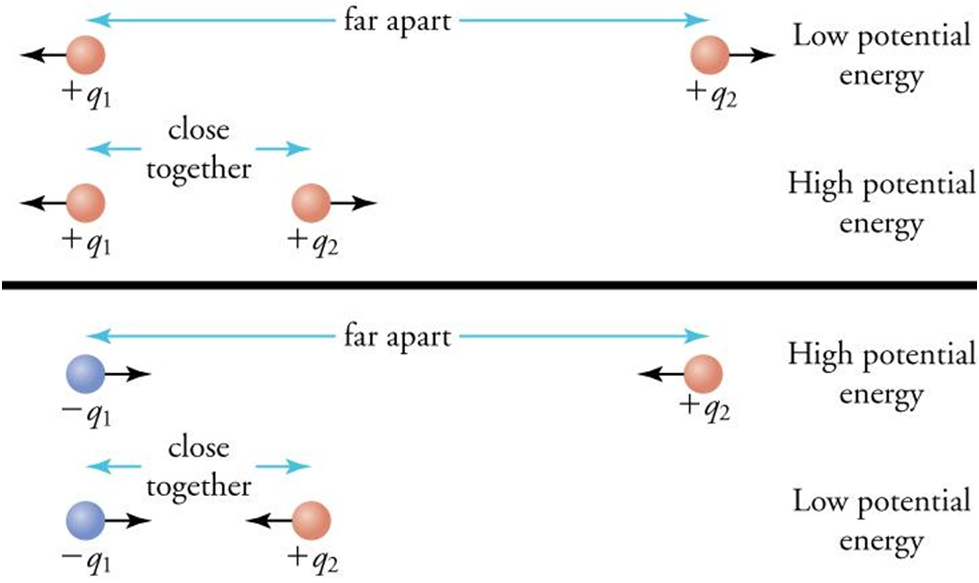
Electric Potential
Electric potential is the work done per unit charge in order to bring that charge from infinity to a point in the electrostatic field.
Electric potential is referred to as Voltage and it is a scalar quantity.
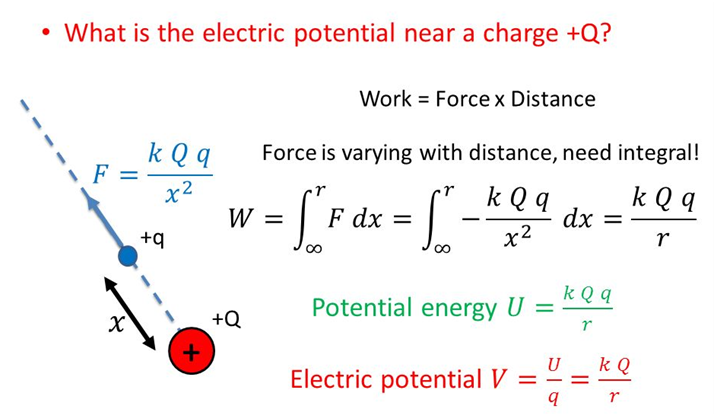
Now let’s try to understand the electric potential difference
Electric Potential difference
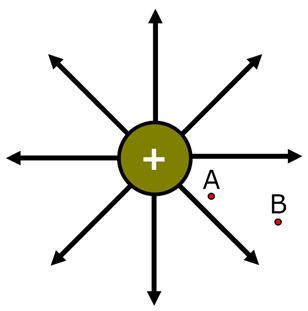
Imagine we have a charge Q. In the figure above you can see two points A and B. A is nearer to charge and B is father to charge. As we know Potential is inversely proportional to “r”. So we can conclude that A is at the higher potential here and B is at the lower potential. The difference in the Potential of A and B is called the Potential difference between A and B.
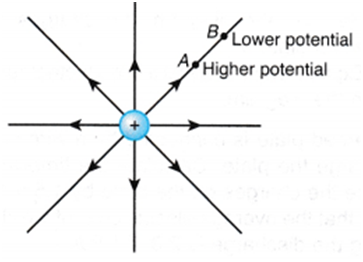
Suppose we have two points A and B at a distance of r1 and r2 from the charge Q. Then the potential difference between A and B will be given as

Va - Vb = K Q( (1/r1)- (1/r2))
S.I. unit of potential difference is the same as potential.
So In the discussion so far, I have tried to give you a detailed explanation of conservative force, the origin of the potential concept. We have discussed Electric potential energy, Electric Potential and its difference in quite a descriptive manner with illustrations of the diagrams.
Electric potential due to multiple charges: Superposition principle.
Like electric force and electric field, Electric potential also follows the principle of superposition. The only difference is that electric potential is scalar, therefore the Electric potential due to multiple charges at a point is simply the algebraic sum of the electric potential due to all individual charges.
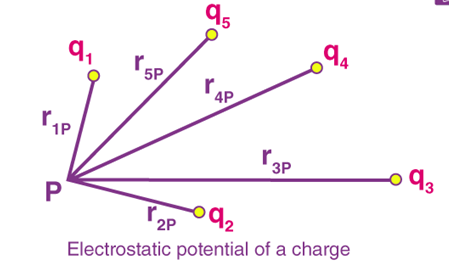
Suppose we have three charges Q1, Q2, Q3 which is at distance r1, r2, r3 respectively from a point P and we wish to find electric potential due to these charges at that point; Electric potential due to three charges will be simply the sum due to individual charges Like shown in the figure.
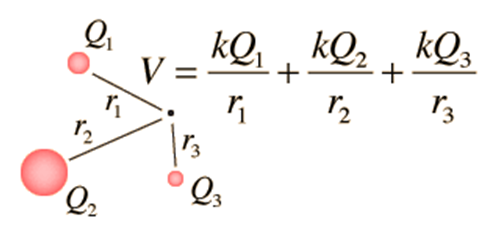
Electric potential due to Electric dipole.
In the previous chapter, we have discussed the Electric field due to electric dipoles at axial and equatorial positions.
In this section, we will discuss the electric potential at axial and equatorial positions.
Be assured! This is much easier than finding an Electric field as electric potential is a scalar quantity, unlike an electric field which is a vector quantity.
So we can do an algebraic sum in this case, rather than doing vector addition as in the case of electric fields due to dipoles.
Axial position: Suppose we have an electric dipole with charge

Potential at P will be an algebraic sum due to potential due to +q and -q charges which are at distance (r+a) and (r-a) respectively.
V at P = V(+q) (potential due to +q) + V(-q)(potential due to -q) = V(+q)+V(-q)

For r >> a, we can neglect ‘a’ in the denominator.
Then V is proportional to the square of the distance between them.
Equatorial Position:
Now suppose we wish to find the electric potential at the equatorial position due to the electric dipole.
Again Potential at P will be an algebraic sum due to potential due to +q and -q charges which are at distance (r+a) and (r-a) respectively.
V at P = V(+q) (potential due to +q) + V(-q)(potential due to -q) = V(+q)+V(-q)
Now we know that Electric potential is directly proportional to the magnitude of charge and inversely proportional to distance.
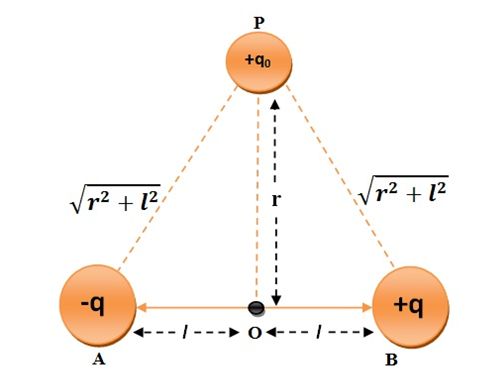
If you closely look at point P you will notice that the distance of P from either charge is the same and also the magnitude of the charges in the dipole is the same.
We can conclude from above that magnitude of potential due to
+q and -q is the same at P, but since one will be positive and the other to be negative so they will cancel each other out. The net electric potential due to the electric dipole at the equatorial position is zero.
Equipotential Surface.
- The surface at which the potential has a constant value is called the equipotential surface.
- The work done in moving a charge on an equipotential surface is zero because the potential at every point of the equipotential surface is the same as work done = charge * Potential difference, Since the potential difference is zero at the equipotential surface W=0
- For any charge configuration, the equipotential surface through a point is normal to the electric field at that point. In other words, we can say that electric field lines are perpendicular to the equipotential surface.
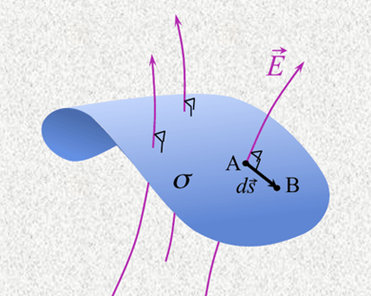
- The equipotential surfaces of a single point charge are concentric spherical surfaces centered at the charge
- Equipotential surfaces due to the uniform electric field are planes normal to the direction of the electric field.
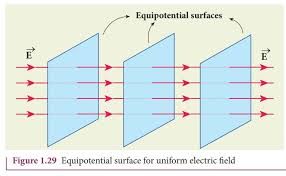
- Equipotential surfaces due to electric dipole are also spheres perpendicular to electric field lines as shown in the figure below.
You will notice that the equipotential surfaces are neat to each other in between the charges and are farther on the other side.
This is because there are more electric field lines are more between the charges.
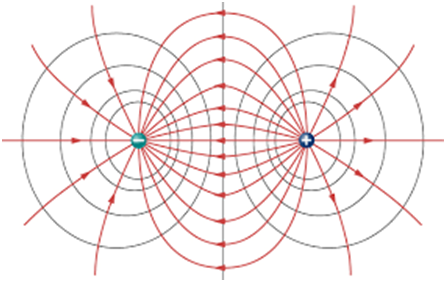
- Equipotential surface due to two similar charges ( say both positive) will also be a concentric sphere but in this case, equipotential surfaces are far from each other in between the charges and near to end on the other side. The reason is the same again as the electric field in between similar charges is less in between the similar charges.
- Equipotential surface due to two similar charges ( say both positive) will also be a concentric sphere but in this case, equipotential surfaces are far from each other in between the charges and near to end on the other side. The reason is the same again as the electric field in between similar charges is less in between the similar charges.
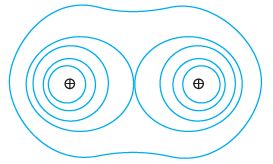
Relation between Electric field and electric potential
The concept of Electric field and Electric potential is introduced to understand and visualize how charges which are kept at a distance exert force on each other without any physical contact. But Electric field is a vector quantity and the electric potential is a scalar quantity and hence much simpler to deal with.
So there must be some connection between electric field and electric potential.
When V is given and E has to find out we will use the following relation.
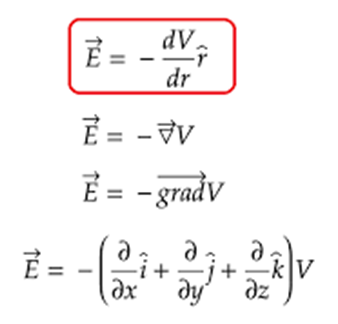
When E is given and a potential difference is to be found out, we will use the following relation.

- Books Name
- Physics Book Part l and ll
- Publication
- Grow Career Publication
- Course
- CBSE Class 12
- Subject
- Physics
Chapter 2: Electrostatic Potential and Capacitance
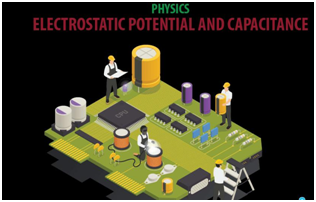
Electrostatic Potential

We define potential energy of a test charge q in terms of the work done on the charge q. This work is obviously proportional to q, since the force at any point is qE, where E is the electric field at that point due to the given charge configuration. It is, therefore, convenient to divide the work by the amount of charge q, so that the resulting quantity is independent of q. In other words, work done per unit test charge is characteristic of the electric field associated with the charge configuration
POTENTIAL DUE TO A POINT CHARGE
Take Q to be positive. We wish to determine the potential at any point P with position vector r from the origin. For that we must calculate the work done in bringing a unit positive test charge from infinity to the point P. For Q > 0, the work done against the repulsive force on the test charge is positive.
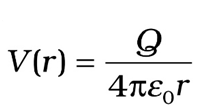
Potential due to an electric dipole
What is the electric potential due to an electric dipole at an equatorial point? Zero, as potential on equatorial point, due to charges of electric dipole, are equal in magnitude but opposite in nature and hence their resultant is zero.
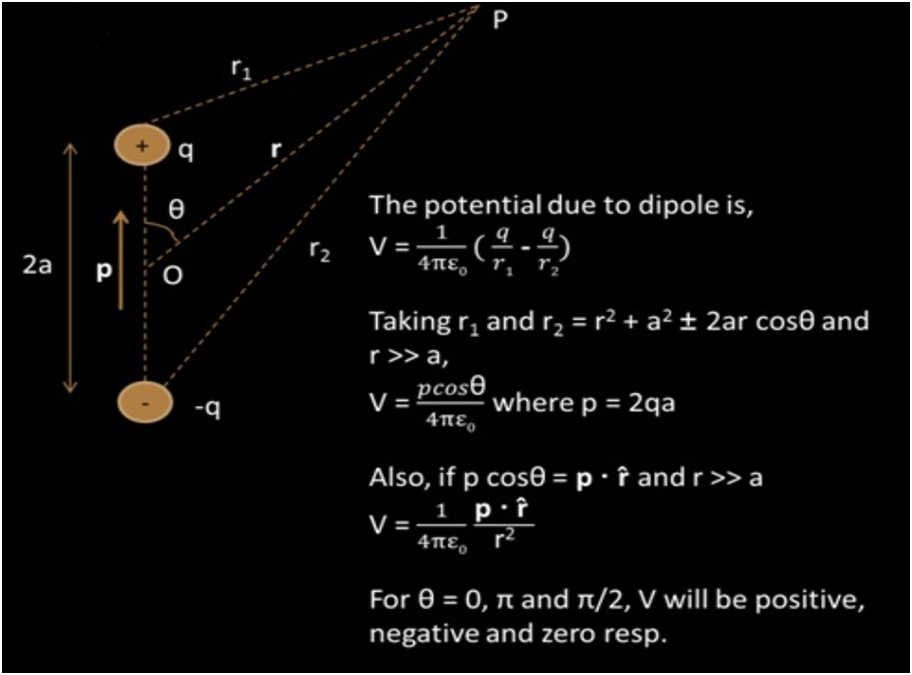
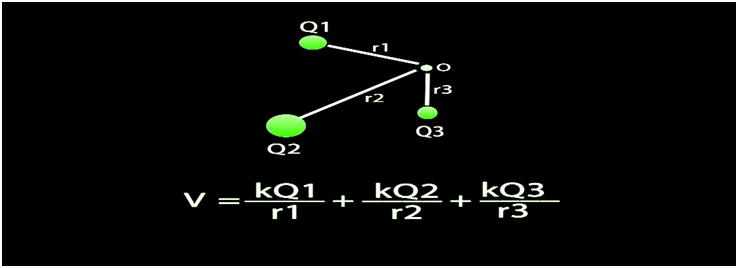
Potential due to system charges
derive an expression for the electric field at a point due to a system of n point charges. When there is a group of point charges say q1, q2, q3,….qn is kept at a distance r1, r2, r3,……rn, we can get the electrostatic potential at any particular point.
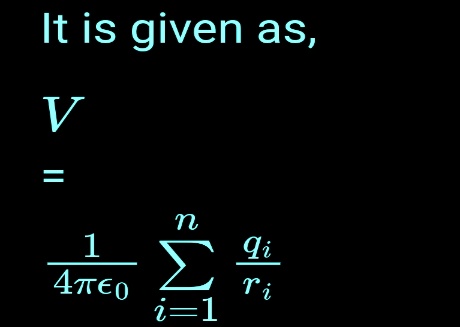
Equipotential surface.
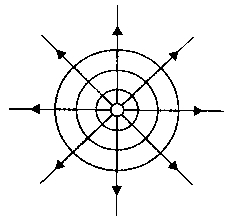
If the points in an electric field are all at the same electric potential, then they are known as the equipotential points. If these points are connected by a line or a curve, it is known as an equipotential line. If such points lie on a surface, it is called an equipotential surface.
Work Done in Equipotential Surface
The work done in moving a charge between two points in an equipotential surface is zero. Then the work done in moving the charge is given by
W = q0(VA –VB)
As VA – VB is equal to zero, the total work done is W = 0.

 Madhava Publications
Madhava Publications
 Grow Career Publication
Grow Career Publication
